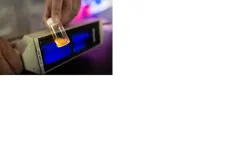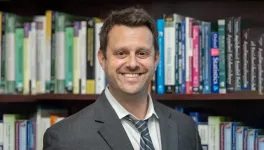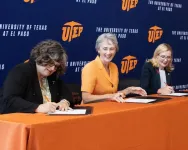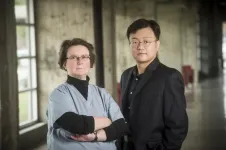(Press-News.org) Cells are highly controlled spaces that rely on every protein being in the right place. Many diseases, including cancers and neurodegenerative disorders, are associated with misplaced proteins. In some cancers, for instance, a protein that normally stands watch over DNA replicating in the nucleus is sent far from the DNA it is meant to monitor, allowing cancers to grow.
Steven Banik, assistant professor of chemistry in the School of Humanities and Sciences and institute scholar at Sarafan ChEM-H at Stanford University, and his lab have developed a new method to help force misplaced proteins back to their proper homes within cells. The method involves rewiring the activity of naturally occurring shuttles to help move proteins to different parts of the cell. The team has devised a new class of molecules called “targeted relocalization activating molecules” or TRAMs that convince these natural shuttles to take different cargo – like the proteins that get exported from the nucleus in some cancers – along for the ride. Published in Nature on Sept. 18, this strategy could lead to a therapeutic to correct the protein misplacement associated with diseases, and also to create new functions in cells.
“We are taking proteins that are lost and bringing them back home,” said Banik.
Shuttles and passengers
Our cells contain many compartments, like the nucleus, the secure home of DNA, or the mitochondria, where energy is produced. In between all these compartments is the cytoplasm. All throughout the cell’s many locations are proteins. They are responsible for all sorts of actions – building and breaking molecules, contracting muscles, sending signals – but for them to function properly, they have to do their respective actions in the right place.
“Cells are really crowded places,” said Banik. “Proteins are whizzing through the crowd passing by all kinds of other molecules like RNA, lipids, other proteins. So a protein’s function is limited by what it can do and by its proximity to other molecules.”
Diseases will sometimes take advantage of this need for proximity by mutating proteins that might otherwise be able to protect a cell from damage. These kinds of mutations are like putting the wrong address on a package, tricking proteins into going where they would never go in healthy cells.
Sometimes, this movement makes the protein stop working altogether. Proteins that act on DNA, for instance, will not find any DNA in the cytoplasm and float off doing nothing. Other times, this movement leads to a protein becoming a bad actor. In ALS, for example, a mutation sends a certain protein, called FUS, out of the nucleus and into the cytoplasm, where it aggregates into toxic clumps and eventually kills the cell.
Banik and his team wondered whether they could combat this purposeful misplacement of proteins by using other proteins as shuttles to carry passenger proteins to their proper home. But these shuttles often have other functions, so the team would need to convince the shuttle to take on cargo and transport it to a new place.
To do this, Banik and his team developed a new kind of two-headed molecule called a TRAM. One head is designed to stick to the shuttle, and the other is designed to stick to the passenger. If the shuttle is strong enough, it will carry the passenger to its rightful place.
Along for the ride
The team focused on two promising types of shuttles, one that drags proteins into the nucleus, and another that exports proteins from the nucleus. Christine Ng, a chemistry graduate student and first author on the paper, designed and built TRAMs that hitch together shuttle and passenger. If a passenger in the cytoplasm ended up in the nucleus, they would know their TRAM had worked.
The first challenge was immediate: there were no reliable methods to measure the amount of a protein in a specific location in individual cells. So Ng developed a new method to quantify the amount and location of passenger proteins within a cell at a given time. A chemist by training, she had to learn new skills of microscopy and computational analysis to do this.
“Nature is inherently complex and interconnected, so it’s crucial to have interdisciplinary approaches,” said Ng. “Borrowing logic or tools from one field to address a problem in another field often results in very exciting ‘what if’ questions and discoveries.”
Next, she put it to the test. Her TRAMs successfully moved passenger proteins into and out of the nucleus, depending on the shuttle they used. These early experiments helped her generate some basic “rules” for design, like how strong a shuttle had to be to overcome the passenger’s tendency to pull in another direction.
The next challenge was whether they could design TRAMs that could be medicines, ones that reverse disease-causing protein movement. First, they created a TRAM that would relocalize FUS, the protein that gets shipped out of the nucleus and forms dangerous granules in ALS patients. After treating cells with their TRAM, the team saw that FUS was transported back into its natural home in the nucleus, and that the toxic clumps decreased and the cells were less likely to die.
They then turned their attention to a well-known mutation in mice that makes them more resistant to neurodegeneration. The mutation, famously studied by the late Ben Barres and others, causes a certain protein to travel away from the nucleus down the axon in neurons.
The team wondered if they could build a TRAM that would mimic the protective effect of the mutation, taking the protein for a ride down to the end of the axon. Their TRAM not only moved the target protein down the axon, but also made the cell more resistant to stress that mimics neurodegeneration.
In all these examples, the team faced an ongoing challenge: Designing the passenger-targeting head of the TRAM is difficult because scientists have not yet identified all the possible molecules that could bind to their target passengers. To get around this, the team used genetic tools to install a sticky tag onto these passengers. In the future, though, they hope that they will be able to find naturally occurring sticky pieces on these passengers, and develop TRAMs into new kinds of medicines.
Though they focused on two shuttles, the method is generalizable to any other shuttles, like those that push things to the cell surface, where communication with other cells occurs.
And beyond sending mutated proteins back to where they belong, the team also hopes that TRAMs could be used to send healthy proteins to parts of the cell that they cannot normally access, creating new functions that we do not yet know are possible.
“It’s exciting because we are just starting to learn the rules,” said Banik. “If we shift the balance, if a protein suddenly has access to new molecules in a new part of the cell at a new time, what will it do? What functions could we unlock? What new piece of biology could we understand?”
Banik is also a member of Bio-X and of the Wu Tsai Human Performance Alliance. Other Stanford co-authors include Aofei Liu, a former graduate student in chemistry, and Bianxiao Cui, the Job and Gertrud Tamaki Professor of Chemistry. Cui is a member of Bio-X, the Cardiovascular Institute, and the Wu Tsai Neurosciences Institute, and is a faculty fellow of Sarafan ChEM-H. This work was supported by an A*STAR fellowship and by the NIH/NIGMS.
END
Bringing lost proteins back home
2024-09-20
ELSE PRESS RELEASES FROM THIS DATE:
Better than blood tests? Nanoparticle potential found for assessing kidneys
2024-09-20
In a study published July 29 in Advanced Materials, University of Texas at Dallas researchers found that X-rays of the kidneys using gold nanoparticles as a contrast agent might be more accurate in detecting kidney disease than standard laboratory blood tests. Based on their study in mice, they also found that caution may be warranted in employing renal-clearable nanomedicines to patients with compromised kidneys.
Before administering renal-clearable drugs, doctors routinely check a patient’s kidney function by testing their ...
Texas A&M and partner USAging awarded 2024 Immunization Neighborhood Champion Award
2024-09-20
The Texas A&M University School of Public Health and USAging have been awarded the 2024 Immunization Neighborhood Champion Award by the U.S. Centers for Disease Control’s National Adult and Influenza Immunization Summit. Matthew Lee Smith, PhD, professor at the School of Public Health, leads the school’s involvement as a founding member of USAging’s Aging and Disability Vaccination Collaborative (ADVC).
Announced as respiratory illness season is ramping up in the United States, this honor recognizes Smith’s work in support of ADVC’s efforts ...
UTEP establishes collaboration with DoD, NSA to help enhance U.S. semiconductor workforce
2024-09-20
EL PASO, Texas (Sept. 20, 2024) – The University of Texas at El Paso today announced new collaborations with the Department of Defense (DoD) and the National Security Agency (NSA) that support research and training to strengthen the nation’s leadership in semiconductor, or microchips, technology.
NSA, the signals intelligence and cybersecurity agency for the United States, also recently named UTEP as an NSA Center of Academic Excellence in Cybersecurity Research, making UTEP one of only 11 universities nationwide to hold all three ...
Study finds family members are most common perpetrators of infant and child homicides in the U.S.
2024-09-20
Homicide is a leading cause of death among people 19 and younger in the United States, and firearms are used in a large proportion of these crimes. Although the homicide rate for this population declined in the 1990s and 2000s, it has increased every year since 2013, with a large spike during the COVID-19 pandemic.
Now, new research by Hannah Rochford, PhD, an assistant professor with the Texas A&M University School of Public Health, and two colleagues from the University of Iowa, provides insight into the characteristics of ...
Researchers secure funds to create a digital mental health tool for Spanish-speaking Latino families
2024-09-20
Cory Cobb, PhD, an assistant professor of health behavior at the Texas A&M University School of Public Health, is leading a research team that has been awarded a three-year grant from the National Institute of Mental Health to create an online platform for the intervention program they developed for United States-based Spanish-speaking Latino parents and their children.
The Latino Youth and Family Empowerment (LYFE) program focused on Nuestras Familias: Andando Entre Culturas (Our Families: Walking between Cultures), an intervention designed to enhance the parenting ...
UAB startup Endomimetics receives $2.8 million Small Business Innovation Research grant
2024-09-20
BIRMINGHAM, Ala. – The University of Alabama at Birmingham startup company Endomimetics, LLC, has received a $2.8 million Small Business Innovation Research Phase II grant from National Institute of Neurological Disorders and Stroke.
Under the grant, Endomimetics co-founders Ho-Wook Jun, Ph.D., a professor in the UAB Department of Biomedical Engineering, and Brigitta Brott, M.D., a professor in the UAB Department of Medicine Division of Cardiovascular Disease, will collaborate with Ramanathan Kadirvel, Ph.D., a professor of neurosurgery and radiology at Mayo Clinic, and David Kallmes, M.D., a professor of radiology at Mayo Clinic, Rochester, Minnesota, to develop a BionanomatrixTM ...
Scientists turn to human skeletons to explore origins of horseback riding
2024-09-20
As anyone who’s spent time in the saddle knows, riding a horse can be hard on your body. But can it change the way your skeleton looks?
The answer, according to archaeologists from the University of Colorado Boulder: It’s complicated. In a new study, the team drew on a wide range of evidence—from medical studies of modern equestrians to records of human remains across thousands of years.
The researchers concluded that horseback riding can, in fact, leave a mark on human skeletons, such as by subtly altering the shape of the hip joint. But those sorts of changes on their own can’t definitively reveal whether people have ridden ...
UCF receives prestigious Keck Foundation Award to advance spintronics technology
2024-09-20
UNIVERSITY OF CENTRAL FLORIDA
UCF Receives Prestigious Keck Foundation Award to Advance Spintronics Technology
The work could change the future of electronics, making them faster and more energy efficient.
ORLANDO, Sept. 20, 2024 – A team of researchers led by University of Central Florida Pegasus Professor of Physics Enrique Del Barco is working on a new project that could change the future of electronics, making them faster and more energy efficient.
The work is funded by a new $1.3 million award from the W.M. Keck Foundation, one of the nation’s ...
Cleveland Clinic study shows bariatric surgery outperforms GLP-1 diabetes drugs for kidney protection
2024-09-20
Cleveland Clinic Study Shows Bariatric Surgery Outperforms GLP-1 Diabetes Drugs for Kidney Protection
Bariatric surgery was shown to protect kidney function and reduce the risk of kidney failure in study participants when compared to GLP-1 medications
Friday, September 20, 2024, CLEVELAND: A Cleveland Clinic study showed that in patients with type 2 diabetes, obesity, and chronic kidney disease, bariatric surgery was associated with a significant decrease in the progression of chronic kidney disease compared to those who received GLP-1 diabetes medications. The paper was published in Annals ...
Study reveals large ocean heat storage efficiency during the last deglaciation
2024-09-20
As one of the largest heat reservoirs in the climate system, the global ocean absorbs more than 90% of the excess energy from ongoing anthropogenic warming. In the last century, the greatest warming in the ocean has occurred in the upper 500 m, with relatively weak warming in the deep ocean, corresponding to a small ocean heat storage efficiency of ~0.1.
Paleoceanographic observations, however, suggest that on long time scales, the deep ocean warming can be comparable to or larger than the surface ocean warming, with ocean heat storage efficiency during the last ...




